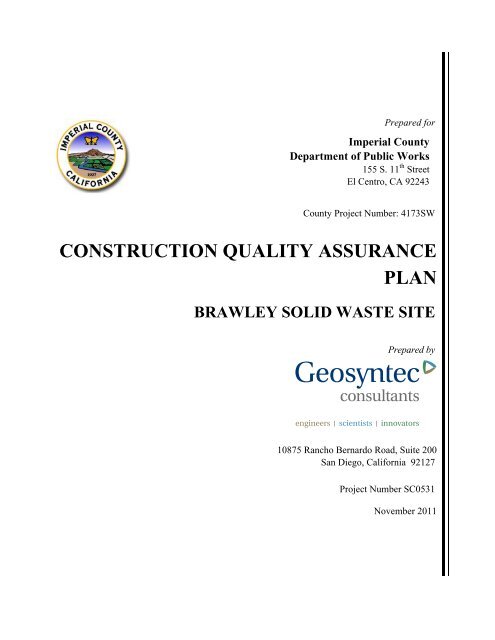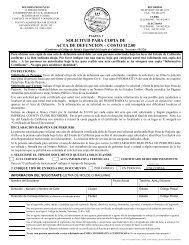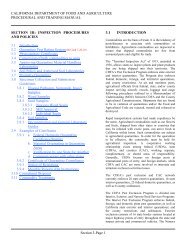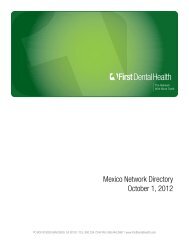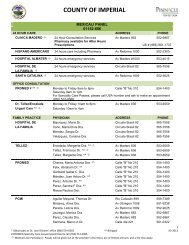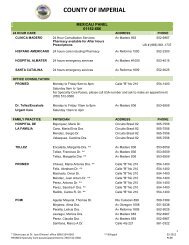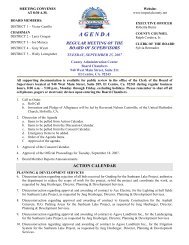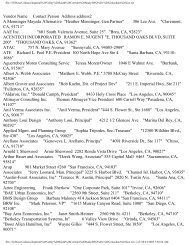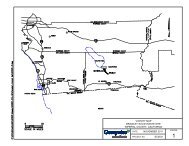construction quality assurance plan brawley ... - County of Imperial
construction quality assurance plan brawley ... - County of Imperial
construction quality assurance plan brawley ... - County of Imperial
You also want an ePaper? Increase the reach of your titles
YUMPU automatically turns print PDFs into web optimized ePapers that Google loves.
Prepared for<br />
<strong>Imperial</strong> <strong>County</strong><br />
Department <strong>of</strong> Public Works<br />
155 S. 11 th Street<br />
El Centro, CA 92243<br />
<strong>County</strong> Project Number: 4173SW<br />
CONSTRUCTION QUALITY ASSURANCE<br />
PLAN<br />
BRAWLEY SOLID WASTE SITE<br />
Prepared by<br />
10875 Rancho Bernardo Road, Suite 200<br />
San Diego, California 92127<br />
Project Number SC0531<br />
November 2011
TABLE OF CONTENTS<br />
1. INTRODUCTION ................................................................................................ 1<br />
1.1 Project Overview ......................................................................................... 1<br />
1.2 Purpose <strong>of</strong> the Construction Quality Assurance Plan .................................. 1<br />
1.3 References ................................................................................................... 1<br />
2. DEFINITIONS ..................................................................................................... 3<br />
3. PARTIES INVOLVED WITH CONSTRUCTION QUALITY ASSURANCE .. 4<br />
3.1 Owner .......................................................................................................... 4<br />
3.2 Engineer ....................................................................................................... 4<br />
3.3 Construction Manager ................................................................................. 4<br />
3.4 Contractor .................................................................................................... 5<br />
3.5 CQA Personnel ............................................................................................ 5<br />
3.6 CQA Engineer ............................................................................................. 5<br />
3.7 Field Monitors ............................................................................................. 6<br />
4. PROJECT CONTROL MEETINGS .................................................................... 8<br />
4.1 Pre<strong>construction</strong> Meeting .............................................................................. 8<br />
4.2 Progress Meetings ........................................................................................ 9<br />
4.3 Problem or Work Deficiency Meeting ........................................................ 9<br />
5. DOCUMENTATION ......................................................................................... 10<br />
5.1 General ....................................................................................................... 10<br />
5.2 Daily Recordkeeping ................................................................................. 10<br />
5.2.1 Monitoring Logs and Testing Data Sheets .................................... 10<br />
5.2.2 Construction Problems .................................................................. 11<br />
5.3 Design and/or Specifications Changes ...................................................... 11<br />
5.4 As-Built Drawings ..................................................................................... 11<br />
5.5 Final CQA Report ...................................................................................... 12<br />
6. MONOLITHIC FINAL SOIL COVER .............................................................. 13<br />
6.1 Monitoring ................................................................................................. 13<br />
6.2 Laboratory and Field Tests ........................................................................ 14<br />
6.3 Survey ........................................................................................................ 14<br />
6.4 Deficiencies ............................................................................................... 14<br />
SC0531.CQA.20110923.JG.docx ii November 2011
6.4.1 Notification ................................................................................... 15<br />
6.4.2 Corrective Action .......................................................................... 15<br />
6.4.3 Repairs and Retesting .................................................................... 15<br />
7. ENGINEERED FILL .......................................................................................... 17<br />
7.1 Monitoring ................................................................................................. 17<br />
7.2 Laboratory and Field Tests ........................................................................ 17<br />
7.3 Deficiencies ............................................................................................... 18<br />
7.3.1 Notification ................................................................................... 18<br />
7.3.2 Corrective Action .......................................................................... 18<br />
7.3.3 Repairs and Retesting .................................................................... 18<br />
8. WASTE RELOCATION .................................................................................... 20<br />
8.1 Monitoring ................................................................................................. 20<br />
8.2 Deficiencies ............................................................................................... 21<br />
8.2.1 General .......................................................................................... 21<br />
8.2.2 Notification ................................................................................... 21<br />
8.2.3 Corrective Action .......................................................................... 21<br />
9. GEOSYNTHETICS ............................................................................................ 22<br />
9.1 Manufacturing Quality Control Testing .................................................... 22<br />
9.2 Delivery, Storage, and Handling ............................................................... 22<br />
9.3 Handling and Placement ............................................................................ 23<br />
10. SURFACE WATER DRAINAGE CONTROL SYSTEM ................................. 25<br />
10.1 General ....................................................................................................... 25<br />
10.2 Delivery, Storage, and Handling ............................................................... 25<br />
10.3 Material Properties .................................................................................... 25<br />
10.3.1 Quality Control Testing ................................................................ 25<br />
10.3.2 Quality Assurance Testing ............................................................ 26<br />
10.4 Placement ................................................................................................... 26<br />
10.4.1 Bedding Material ........................................................................... 26<br />
10.4.2 Riprap ............................................................................................ 26<br />
10.4.3 Pipe ................................................................................................ 27<br />
SC0531.CQA.20110923.JG.docx iii November 2011
11. RIVER BANK STABILIZATION ..................................................................... 28<br />
11.1 Delivery, Storage, and Handling ............................................................... 28<br />
11.2 Material Properties .................................................................................... 28<br />
11.2.1 Quality Control Testing ................................................................ 28<br />
11.2.2 Quality Assurance Testing ............................................................ 28<br />
11.3 Placement ................................................................................................... 28<br />
12. SURVEYING ..................................................................................................... 30<br />
12.1 Survey Control ........................................................................................... 30<br />
12.2 Precision and Accuracy ............................................................................. 30<br />
12.3 Survey Control ........................................................................................... 30<br />
12.4 Frequency and Spacing .............................................................................. 31<br />
12.5 Documentation ........................................................................................... 31<br />
LIST OF TABLES<br />
Table 1: Final Cover Field and Laboratory Testing<br />
Table 2: Engineered Fill Field and Laboratory Testing<br />
SC0531.CQA.20110923.JG.docx iv November 2011
1. INTRODUCTION<br />
This <strong>plan</strong> describes the <strong>construction</strong> <strong>quality</strong> <strong>assurance</strong> (CQA) for the monolithic final<br />
cover, engineered fill, waste relocation, geosynthetics, surface drainage control system,<br />
and river bank stabilization system (closure activities) associated with the Brawley<br />
Solid Waste Site (BSWS) final closure. The <strong>plan</strong> was prepared in accordance with the<br />
California Code <strong>of</strong> Regulations, Title 27 (27 CCR) Sections 20323 and 20324.<br />
1.1 Project Overview<br />
The <strong>Imperial</strong> <strong>County</strong> Department <strong>of</strong> Public Works (ICDPW) is closing the BSWS,<br />
which is an inactive Class III municipal solid waste landfill located at 4700 Brawley<br />
Dump Road in Brawley, California. The site is approximately 55 acres, 36.3 acres <strong>of</strong><br />
which are the current estimated waste footprint.<br />
1.2 Purpose <strong>of</strong> the Construction Quality Assurance Plan<br />
The purpose <strong>of</strong> the CQA Plan is to address the CQA procedures and monitoring<br />
requirements for final closure activities at the BSWS. The CQA Plan is intended to:<br />
� Define the responsibilities <strong>of</strong> the parties involved with the <strong>construction</strong>;<br />
� Provide guidance in the proper <strong>construction</strong> <strong>of</strong> the significant <strong>construction</strong><br />
components <strong>of</strong> the landfill closure;<br />
� Establish testing protocols;<br />
� Establish guidelines for <strong>construction</strong> documentation; and<br />
� Provide means for monitoring that the <strong>construction</strong> is performed in conformance<br />
with the Technical Specifications, Construction Drawings, permit conditions,<br />
and applicable regulatory requirements.<br />
This <strong>plan</strong> does not provide CQA for installation or maintenance procedures for storm<br />
water pollution prevention features. These features are assumed to be installed and<br />
maintained by the Contractor in accordance with the Storm Water Pollution Prevention<br />
Plan (SWPPP).<br />
1.3 References<br />
This CQA Plan includes references to the Technical Specifications developed as a part<br />
<strong>of</strong> the Final Closure-Post Closure Maintenance Plan (FCPCMP) for the BSWS. The<br />
SC0531.CQA.20110923.JG.docx 1 November 2011
CQA Plan also references the American Society for Testing and Materials (ASTM)<br />
testing procedures and the Standard Specifications for Public Works Construction<br />
(SSPWC), also known as the “Greenbook”. The <strong>construction</strong> will utilize the latest<br />
edition <strong>of</strong> these references.<br />
SC0531.CQA.20110923.JG.docx 2 November 2011
2. DEFINITIONS<br />
In the context <strong>of</strong> this document, Construction Quality Assurance and Construction<br />
Quality Control are defined as follows:<br />
Construction Quality Assurance (CQA) - A <strong>plan</strong>ned and systematic pattern <strong>of</strong> means<br />
and actions designed to assure adequate confidence that materials and/or services meet<br />
contractual and regulatory requirements and will perform satisfactorily in service.<br />
Construction Quality Control (CQC) - Those actions which provide a means to measure<br />
and regulate the characteristics <strong>of</strong> an item or service in relation to contractual and<br />
regulatory requirements.<br />
In the context <strong>of</strong> this document:<br />
� CQA refers to means and actions employed by the CQA Consultant to assure<br />
conformity <strong>of</strong> the Project “work” with this CQA Plan, the Construction<br />
Drawings, and the Technical Specifications, known collectively as the Project<br />
Documents.<br />
� CQC refers to those actions taken by the Contractor, Manufacturer, or<br />
subcontractor to verify that the materials and the workmanship meet the<br />
requirements <strong>of</strong> the Project Documents. In the case <strong>of</strong> earthwork components,<br />
CQC is combined with CQA and is provided by the CQA Consultant. In the<br />
case <strong>of</strong> the geosynthetic and piping components <strong>of</strong> the work, CQC is provided<br />
by the Manufacturer and/or the Contractor. CQA testing <strong>of</strong> soil and rock<br />
components is provided by the CQA Consultant.<br />
SC0531.CQA.20110923.JG.docx 3 November 2011
3. PARTIES INVOLVED WITH CQA<br />
3.1 Owner<br />
Responsibilities<br />
The Owner is the legally responsible party for the project. In this CQA Plan, the term<br />
“Owner” refers to ICDPW. The Owner is responsible for selection <strong>of</strong> the Engineer,<br />
Construction Manager, CQA Consultant, and Contractor.<br />
3.2 Engineer<br />
Responsibilities<br />
The Engineer is responsible for the preparation <strong>of</strong> the design, Construction Drawings,<br />
and Technical Specifications for the closure activities. In this CQA Plan, the term<br />
“Engineer” refers to Geosyntec Consultants, Inc. (Geosyntec).<br />
Qualifications<br />
The Engineer <strong>of</strong> Record shall be a qualified engineer, registered as required by<br />
California regulations. The Engineer will have expertise which demonstrates significant<br />
familiarity with landfill and earthwork, including design and <strong>construction</strong> experience<br />
related to monolithic final cover systems and river bank stabilization systems.<br />
3.3 Construction Manager<br />
Responsibilities<br />
The Construction Manager is responsible for overseeing the <strong>construction</strong> and the<br />
Contractor’s work. The Construction Manager is also the liaison between the Owner<br />
and the Contractor.<br />
Qualifications<br />
The Construction Manager shall have familiarity and experience with waste and/or<br />
landfill sites, earthwork, and <strong>construction</strong> experience related to evapotranspiration cover<br />
systems.<br />
SC0531.CQA.20110923.JG.docx 4 November 2011
3.5 Contractor<br />
Responsibilities<br />
In this CQA Plan, Contractor refers to party or parties, contracted by the Owner,<br />
performing the work. The Contractor will be responsible for constructing the closure<br />
components in general accordance with the Project Documents and complying with the<br />
CQC requirements in the Technical Specifications.<br />
Qualifications<br />
Qualifications <strong>of</strong> the Contractor are specific to the <strong>construction</strong> contract. The<br />
Contractor should have a demonstrated history <strong>of</strong> successful earthwork <strong>construction</strong> and<br />
maintain current state and federal licenses as appropriate.<br />
3.6 CQA Consultant<br />
For closure activities at the BSWS, the CQA Consultant’s personnel shall include:<br />
� The CQA Engineer, who operates from the <strong>of</strong>fice <strong>of</strong> the CQA Consultant and<br />
who conducts periodic visits to the site as required; and<br />
� Field Monitor(s), who are located at the site.<br />
The duties <strong>of</strong> the CQA personnel are discussed in the following sections.<br />
3.7 CQA Engineer<br />
The CQA Engineer or his designated representative:<br />
� Reviews the design and Construction Drawings;<br />
� Reviews all other site-specific documentation; unless otherwise agreed, such<br />
reviews are for familiarization and for evaluation <strong>of</strong> constructability only, and<br />
hence the CQA Engineer and the CQA Consultant assume no responsibility for<br />
the design;<br />
� Attends the pre<strong>construction</strong> meeting;<br />
� Administers the CQA program, including assigning and managing Field<br />
Monitors, reviewing field reports, and providing engineering review <strong>of</strong> all CQArelated<br />
activities;<br />
SC0531.CQA.20110923.JG.docx 5 November 2011
� Provides <strong>quality</strong> control <strong>of</strong> CQA documentation and conducts site visits;<br />
� Reviews proposed changes to the Project Documents;<br />
� Familiarizes Field Monitors with the site, Project Documents, and CQA<br />
requirements;<br />
� Manages the daily activities <strong>of</strong> the Field Monitors;<br />
� Attends CQA-related meetings;<br />
� Prepares or oversees the preparation <strong>of</strong> the record drawings;<br />
� Verifies the calibration and condition <strong>of</strong> on-site CQA equipment;<br />
� Reports to the Owner and documents relevant Field Monitor observations;<br />
� Oversees the collection and shipping <strong>of</strong> laboratory test samples;<br />
� Reviews results <strong>of</strong> laboratory testing and makes recommendations;<br />
� Reports unresolved deviations from the Project Documents to the Owner and<br />
Engineer; and<br />
� Prepares the final CQA report.<br />
3.8 Field Monitors<br />
The duties <strong>of</strong> the Field Monitors, as assigned by the CQA Engineer, include monitoring<br />
and documenting <strong>construction</strong> <strong>of</strong> closure activities. Specifically, these duties include:<br />
� Acting as the on-site (resident) representative <strong>of</strong> the CQA Consultant;<br />
� Monitoring <strong>of</strong> material stockpiles;<br />
� Assuring proper surface-water drainage away from soil stockpiles and exposed<br />
waste;<br />
� Collecting soil samples for material conformance testing;<br />
� Preparing daily field reports;<br />
� Recording CQA activities on field logs;<br />
� Reporting problems to the CQA Engineer and Engineer;<br />
� Assisting with collection <strong>of</strong> test samples in accordance with the CQA Plan;<br />
SC0531.CQA.20110923.JG.docx 6 November 2011
� Monitoring closure activities;<br />
� Visually examining soil, rock and geosynthetics as placed; and<br />
� Monitoring soil layer repair operations.<br />
In addition to these specific duties, Field Monitors will take note <strong>of</strong> on-site activities<br />
that could result in damage to the closure components. Any observations so noted by<br />
the Field Monitors will be reported immediately to the Construction Manager, Engineer,<br />
and CQA Engineer.<br />
SC0531.CQA.20110923.JG.docx 7 November 2011
4. PROJECT CONTROL MEETINGS<br />
Clear, open channels <strong>of</strong> communication are essential for high <strong>quality</strong> <strong>construction</strong>,<br />
including regular meetings <strong>of</strong> key project personnel.<br />
4.1 Pre<strong>construction</strong> Meeting<br />
A Pre<strong>construction</strong> Meeting will be held at the site prior to closure activities. At a<br />
minimum, the Pre<strong>construction</strong> Meeting will be attended by the CQA Engineer, the<br />
Construction Manager, the Engineer, the Owner, and the Contractor (or their designated<br />
representatives).<br />
Specific requirements for this meeting are to:<br />
� Distribute any relevant documents;<br />
� Review critical project design components;<br />
� Review this CQA Plan and make appropriate modifications or clarifications;<br />
� Review the Project Documents;<br />
� Review the schedule for operations;<br />
� Establish protocols for testing;<br />
� Reach a consensus on the <strong>quality</strong> control procedures, especially on methods <strong>of</strong><br />
determining acceptability <strong>of</strong> the soil materials comprising the monolithic final<br />
cover;<br />
� Assign the responsibilities <strong>of</strong> each party;<br />
� Establish work area security and safety protocol;<br />
� Confirm the methods for documenting and reporting, and distributing<br />
documents;<br />
� Confirm the lines <strong>of</strong> authority and communication;<br />
� Establish protocols for handling deficiencies, repairs, and retesting; and<br />
� Conduct a site reconnaissance to observe the site and to establish soil stockpiling<br />
and staging locations.<br />
SC0531.CQA.20110923.JG.docx 8 November 2011
The Construction Manager or his representative will record the discussions and<br />
decisions <strong>of</strong> the meeting in the form <strong>of</strong> meeting minutes. Copies <strong>of</strong> the meeting minutes<br />
will be distributed to all attendees.<br />
4.2 Progress Meetings<br />
A weekly progress meeting will be held between the CQA Engineer, the Engineer, the<br />
Construction Manager, the Owner, the Contractor, and other concerned parties (or their<br />
designated representatives). The progress meetings will be used to discuss current<br />
progress, <strong>plan</strong>ned activities for the upcoming week, and any new business or revisions<br />
to the work. The CQA Engineer will document problems, decisions, or questions<br />
arising at this meeting in their daily reports. Any matter requiring action which is raised<br />
in this meeting will be reported to the appropriate parties. Minutes <strong>of</strong> the weekly<br />
progress meetings shall be documented by the Construction Manager or his<br />
representative and distributed to all appropriate parties.<br />
4.3 Problem or Work Deficiency Meeting<br />
A special meeting will be held when and if a problem or deficiency is present or likely<br />
to occur. The meeting will be attended by the Construction Manager, the Engineer, the<br />
Owner, the CQA Engineer, the Contractor, and other parties as appropriate (or their<br />
designated representatives). If the problem requires a design modification, the Engineer<br />
should either be present at, consulted prior to, or notified immediately upon conclusion<br />
<strong>of</strong> this meeting. The purpose <strong>of</strong> the meeting is to define and resolve the problem or<br />
work deficiency as follows:<br />
� Define and discuss the problem or deficiency;<br />
� Review alternative solutions;<br />
� Select a suitable solution agreeable to all parties; and<br />
� Implement an action <strong>plan</strong> to resolve the problem or deficiency.<br />
The Construction Manager shall appoint one attendee to record the discussions and<br />
decisions <strong>of</strong> the meeting. The meeting record shall be documented in the form <strong>of</strong><br />
meeting minutes and copies will be distributed to all affected parties. The Construction<br />
Manager will notify appropriate regulatory agencies <strong>of</strong> significant design changes and<br />
obtain their approval, as needed.<br />
SC0531.CQA.20110923.JG.docx 9 November 2011
5. DOCUMENTATION<br />
5.1 General<br />
An effective CQA <strong>plan</strong> depends largely on recognition <strong>of</strong> <strong>construction</strong> activities that<br />
should be monitored and on assigning responsibilities for monitoring <strong>of</strong> each activity.<br />
This is most effectively accomplished and verified by the documentation <strong>of</strong> <strong>quality</strong><br />
<strong>assurance</strong> activities. The CQA Consultant will document that <strong>quality</strong> <strong>assurance</strong><br />
requirements have been addressed and satisfied.<br />
The Field Monitors will maintain signed reports containing descriptive remarks, data<br />
sheets, and logs to verify that monitoring activities have been completed. The Field<br />
Monitors will also maintain at the site a complete file <strong>of</strong> Project Documents, the CQA<br />
Plan, checklists, test procedures, daily logs, and other pertinent documents.<br />
5.2 Daily Recordkeeping<br />
Standard reporting procedures will include preparation <strong>of</strong> daily CQA documentation<br />
which, at a minimum, will consist <strong>of</strong>: (i) field notes, including memoranda <strong>of</strong> meetings<br />
and/or discussions with the Engineer or Construction Manager; (ii) CQA monitoring<br />
logs, and testing data sheets; and (iii) <strong>construction</strong> problem and resolution summary<br />
sheets. This information will be regularly submitted to and reviewed by the CQA<br />
Engineer.<br />
5.2.1 Monitoring Logs and Testing Data Sheets<br />
Monitoring logs and testing data sheets will be prepared daily. At a minimum, these<br />
logs and data sheets will include the following information:<br />
� An identifying sheet number for cross referencing and document control;<br />
� Date, project name, location, and other identification;<br />
� Data on weather conditions;<br />
� A site <strong>plan</strong> showing work areas and locations selected for recovery <strong>of</strong> random<br />
sampling for CQA testing;<br />
� Descriptions and locations <strong>of</strong> ongoing <strong>construction</strong>;<br />
� Equipment and personnel in each work area;<br />
SC0531.CQA.20110923.JG.docx 10 November 2011
� Descriptions and specific locations <strong>of</strong> areas, or units, <strong>of</strong> work being tested and/or<br />
observed and documented;<br />
� Locations where in-situ CQA tests and samples for laboratory CQA tests were<br />
taken;<br />
� A summary <strong>of</strong> test results;<br />
� Calibrations or recalibrations <strong>of</strong> test equipment, and actions taken as a result <strong>of</strong><br />
recalibration;<br />
� Decisions made regarding acceptance <strong>of</strong> units <strong>of</strong> work, and/or corrective actions<br />
to be taken in instances <strong>of</strong> nonconforming test results; and<br />
� Signature <strong>of</strong> the Field Monitors.<br />
5.2.2 Construction Problems<br />
The Construction Manager and Engineer will be made aware <strong>of</strong> any significant<br />
recurring nonconformance with the Project Documents. The cause <strong>of</strong> the<br />
nonconformance will be determined and appropriate changes in procedures or<br />
specifications will be recommended, as appropriate. These changes will be submitted to<br />
the Engineer for approval. When this type <strong>of</strong> evaluation is made, the results will be<br />
documented, and any revision to procedures or specifications will be approved by the<br />
Engineer.<br />
5.3 Design and/or Specifications Changes<br />
Design and/or specifications changes may be required during <strong>construction</strong>. In such<br />
cases, the CQA Engineer will notify the Construction Manager and Engineer. Design<br />
and/or specifications changes will be made only with the written agreement <strong>of</strong> the<br />
Engineer and the LEA (in accordance with 27 CCR, Section 21870(d)) and will take the<br />
form <strong>of</strong> an amendment to the Project Documents. A design change notification (DCN)<br />
will be issued by the Engineer to the Construction Manager, CQA Engineer, and<br />
Contractor and will be included in the CQA Report. The Construction Manager will<br />
notify appropriate regulatory agencies <strong>of</strong> significant design and/or specifications<br />
changes and obtain their approval, as needed.<br />
5.4 As-Built Drawings<br />
SC0531.CQA.20110923.JG.docx 11 November 2011
The findings from the field surveys should be documented on a set <strong>of</strong> as-built drawings<br />
as discussed in Section 12.5.<br />
5.5 Final CQA Report<br />
At the completion <strong>of</strong> the work, the CQA Consultant will submit to the Owner a signed<br />
and sealed final CQA report within 180 days <strong>of</strong> completion <strong>of</strong> closure <strong>construction</strong>.<br />
This report will document that: (i) work has been performed in compliance with the<br />
Construction Drawings and Technical Specifications; (ii) physical sampling and testing<br />
has been conducted at the appropriate frequencies specified in the CQA Plan; and<br />
(iii) required CQA documentation has been completed.<br />
At a minimum, this report will include:<br />
� Summaries <strong>of</strong> all <strong>construction</strong> activities;<br />
� Monitoring logs and testing data sheets, including sample location <strong>plan</strong>s;<br />
� Construction problems and solutions summary sheets;<br />
� Changes from design and specifications;<br />
� As-built drawings;<br />
� As-built costs <strong>of</strong> closure in the same arrangement and sequence as the estimated<br />
costs <strong>of</strong> closure included in the approved final closure <strong>plan</strong>; and<br />
� Certification by a Registered Pr<strong>of</strong>essional Civil Engineer or Engineering<br />
Geologist in the State <strong>of</strong> California that the BSWS was closed in accordance<br />
with the approved Final Closure Plan, including the Construction Drawings,<br />
Technical Specifications, and CQA Plan.<br />
The as-built drawings will include scale drawings depicting the location <strong>of</strong> the<br />
<strong>construction</strong> and details pertaining to the extent <strong>of</strong> <strong>construction</strong> (e.g., depths, <strong>plan</strong><br />
dimensions, elevations, soil thicknesses, etc.). These documents will be prepared by the<br />
CQA Consultant and included as part <strong>of</strong> the CQA <strong>plan</strong> documentation. Topographic<br />
survey for the project will be provided to the CQA Consultant by the Contractor’s<br />
surveyor.<br />
SC0531.CQA.20110923.JG.docx 12 November 2011
6. MONOLITHIC FINAL COVER<br />
CQA will be performed on soil components used to construct the monolithic final<br />
cover. The criteria to be used to determine acceptability <strong>of</strong> the monolithic final cover<br />
soil is presented in Table 1. Monolithic final cover <strong>construction</strong> and associated<br />
earthwork will conform to Section 02200 <strong>of</strong> the Technical Specifications.<br />
6.1 Monitoring<br />
The CQA Consultant will monitor and document the <strong>construction</strong> <strong>of</strong> all monolithic final<br />
cover components. Monitoring the <strong>construction</strong> work includes the following:<br />
� Monitoring clearing <strong>of</strong> the existing intermediate cover surface;<br />
� Monitoring the scarification and recompaction <strong>of</strong> the existing cover surface in<br />
accordance with the approved Final Closure Plan;<br />
� Monitoring the <strong>quality</strong> <strong>of</strong> the material stockpiles and obtaining borrow soil<br />
samples for conformance testing;<br />
� Rejecting material that does not meet the Technical Specifications;<br />
� Testing to determine the moisture content and unit weight <strong>of</strong> each lift <strong>of</strong> soil<br />
during placement and compaction;<br />
� Noting any deficiencies;<br />
� Monitoring the thickness <strong>of</strong> soil lifts;<br />
� Monitoring that the minimum thickness <strong>of</strong> the final cover soil is as indicated in<br />
the approved Final Closure Plan;<br />
� Monitoring the action <strong>of</strong> the compaction and other heavy equipment on the<br />
<strong>construction</strong> surface (i.e., penetration, pumping, cracking, etc.);<br />
� Monitoring the repair and retesting <strong>of</strong> nonconforming areas;<br />
� Monitoring soil for deleterious material;<br />
� Recording field density and field moisture content measurement at location <strong>of</strong><br />
each test on test logs; and<br />
� Reviewing documentation <strong>of</strong> <strong>quality</strong> control test results.<br />
SC0531.CQA.20110923.JG.docx 13 November 2011
Monitoring the earthwork for the foundation layer also specifically includes the<br />
following:<br />
� Monitoring clearing <strong>of</strong> the existing intermediate cover surface in areas <strong>of</strong> waste<br />
relocation (excavation or placement);<br />
� Monitoring the scarification and recompaction <strong>of</strong> the existing intermediate cover<br />
surface in accordance with the approved Final Closure Plan; and<br />
� Visually monitoring the intermediate cover stability under the action <strong>of</strong> the<br />
compaction or other heavy equipment.<br />
6.2 Laboratory and Field Tests<br />
The laboratory and field test methods, laboratory and field testing frequencies, and<br />
criteria used to determine acceptability for monolithic final cover soil materials are<br />
presented in Table 1. An increased testing frequency may be used at the discretion <strong>of</strong><br />
the Engineer or the CQA Consultant when visual observations <strong>of</strong> <strong>construction</strong><br />
performance indicate a potential, existing, or recurring deficiency.<br />
6.3 Survey<br />
The top <strong>of</strong> the monolithic final cover layer shall be surveyed by the Contractor<br />
immediately following the end <strong>of</strong> <strong>construction</strong>. The thickness <strong>of</strong> the monolithic final<br />
cover layer shall be determined by comparing the survey <strong>of</strong> the existing ground surface<br />
with the top <strong>of</strong> the monolithic final cover layer. Alternative methods <strong>of</strong> thickness<br />
verification may be utilized as approved by the Engineer and Construction Manager.<br />
Alternative methods may include, for example, placement <strong>of</strong> metal plates below the<br />
final cover layer and resurvey <strong>of</strong> the plates after final cover placement. In areas where<br />
waste has been relocated, the thickness <strong>of</strong> the monolithic final cover layer shall be<br />
determined by comparing the survey <strong>of</strong> the top <strong>of</strong> exposed waste and the top <strong>of</strong> the<br />
monolithic final cover layer.<br />
6.4 Deficiencies<br />
If a defect is discovered in the monolithic final cover, the Field Monitors will<br />
immediately inform the CQA Engineer or his designated representative. The Field<br />
Monitors, in consultation with the CQA Engineer, will determine the extent and nature<br />
<strong>of</strong> the defect. If the defect is indicated by an unsatisfactory test result, extent <strong>of</strong> the<br />
SC0531.CQA.20110923.JG.docx 14 November 2011
deficient area will be determined by additional tests, observations, a review <strong>of</strong> records,<br />
or other means that the CQA Engineer deems appropriate.<br />
If the defect is related to adverse site conditions, such as overly wet soil or surface<br />
desiccation, the Field Monitors, in consultation with the CQA Engineer, will define the<br />
limits and nature <strong>of</strong> the defect.<br />
6.4.1 Notification<br />
After determining the extent and nature <strong>of</strong> a defect, the CQA Engineer will notify the<br />
Engineer and Construction Manager and schedule appropriate retests when the work<br />
deficiency is to be corrected.<br />
6.4.2 Corrective Action<br />
At locations where the field testing <strong>of</strong> the soil indicates that the compacted unit weight<br />
or moisture content do not meet the requirements presented in Table 1, the failing area<br />
will be reworked as indicated below:<br />
� The Contractor shall recondition and recompact the area represented by that test.<br />
� In-place density and moisture content testing will be performed in the vicinity <strong>of</strong><br />
a nonconforming area to delineate area <strong>of</strong> deficient in-place density and<br />
moisture content.<br />
� As necessary, samples <strong>of</strong> soil material will be obtained from nonconforming<br />
areas for potential laboratory testing to evaluate differences in soil properties<br />
that could contribute to the nonconforming test results.<br />
Criteria to be used for determination <strong>of</strong> acceptability will be as identified in this CQA<br />
Plan. Other tests performed will consist <strong>of</strong> particle size analysis, Atterberg limits, and<br />
permeability.<br />
6.4.3 Repairs and Retesting<br />
The Contractor will correct the deficiency to the satisfaction <strong>of</strong> the CQA Engineer. If a<br />
criterion <strong>of</strong> the Technical Specifications cannot be met, or unusual weather conditions<br />
hinder work, then the CQA Engineer will develop and present to the Engineer suggested<br />
solutions for approval.<br />
SC0531.CQA.20110923.JG.docx 15 November 2011
All retests recommended by the CQA Engineer must verify that the defect has been<br />
corrected before any additional work is performed by the Contractor in the area <strong>of</strong> the<br />
deficiency. The CQA Engineer will also verify that all installation requirements are<br />
met.<br />
Penetrations into the compacted monolithic final cover resulting from sampling or other<br />
activities shall be properly backfilled with hand-tamped monolithic final cover soil<br />
material. The Contractor shall repair perforations and/or excavations resulting from<br />
CQA sampling and testing. All repairs will be inspected by the Field Monitors for<br />
compliance.<br />
SC0531.CQA.20110923.JG.docx 16 November 2011
7. ENGINEERED FILL<br />
CQA will be performed on engineered fill during earthwork <strong>construction</strong>, including but<br />
not limited to, the south and southeastern depression areas, trench backfill, and waste<br />
relocation backfill. The criteria used to determine acceptability <strong>of</strong> engineered fill is<br />
presented in Table 2. Engineered fill will conform to Section 02200 <strong>of</strong> the Technical<br />
Specifications.<br />
7.1 Monitoring<br />
The CQA Consultant will monitor and document the <strong>construction</strong> <strong>of</strong> engineered fill<br />
components. Monitoring the work includes the following:<br />
� Monitoring clearing <strong>of</strong> subgrade;<br />
� Reviewing documentation <strong>of</strong> <strong>quality</strong> control test results;<br />
� Monitoring the <strong>quality</strong> <strong>of</strong> the material stockpiles and obtaining borrow soil<br />
samples for conformance testing;<br />
� Testing to determine the moisture content and unit weight <strong>of</strong> each lift during<br />
placement and compaction <strong>of</strong> soil used in <strong>construction</strong>;<br />
� Noting any deficiencies;<br />
� Monitoring the thickness <strong>of</strong> soil lifts;<br />
� Monitoring the action <strong>of</strong> the compaction and heavy equipment on the<br />
<strong>construction</strong> surface (i.e., penetration, pumping, cracking, etc.);<br />
� Monitoring the repair <strong>of</strong> nonconforming areas and testing perforations; and<br />
� Recording field density and field moisture content measurement at the location<br />
<strong>of</strong> each test on test logs.<br />
7.2 Laboratory and Field Tests<br />
The laboratory and field test methods, laboratory and field testing frequencies, and<br />
criteria used to determine acceptability <strong>of</strong> engineered fill are presented in Table 2. An<br />
increased testing frequency may be used at the discretion <strong>of</strong> the Engineer or the CQA<br />
Consultant when visual observations <strong>of</strong> <strong>construction</strong> performance indicate a potential,<br />
existing, or recurring deficiency.<br />
SC0531.CQA.20110923.JG.docx 17 November 2011
7.3 Deficiencies<br />
If a defect is discovered in the earthwork product, the Field Monitors will immediately<br />
inform the CQA Engineer or his designated representative. The Field Monitors, in<br />
consultation with the CQA Engineer, will determine the extent and nature <strong>of</strong> the defect.<br />
If the defect is indicated by an unsatisfactory test result, extent <strong>of</strong> the deficient area will<br />
be determined by additional tests, observations, a review <strong>of</strong> records, or other means that<br />
the CQA Engineer deems appropriate.<br />
If the defect is related to adverse site conditions, such as overly wet soil or surface<br />
desiccation, the Field Monitors, in consultation with the CQA Engineer, will define the<br />
limits and nature <strong>of</strong> the defect.<br />
7.3.1 Notification<br />
After determining the extent and nature <strong>of</strong> a defect, the CQA Engineer will notify the<br />
Engineer and Construction Manager and schedule appropriate retests when the work<br />
deficiency is to be corrected.<br />
7.3.2 Corrective Action<br />
At locations where the field testing <strong>of</strong> the soil indicates that the compacted unit weight<br />
or moisture content do not meet the requirements presented in Table 2, the failing area<br />
will be reworked as indicated below:<br />
� The Contractor shall recondition and recompact the area represented by that test.<br />
� In-place density and moisture content testing will be performed in the vicinity <strong>of</strong><br />
a nonconforming area to delineate area <strong>of</strong> deficient in-place density and<br />
moisture content.<br />
� As necessary, samples <strong>of</strong> soil material will be obtained from nonconforming<br />
areas for potential laboratory testing to evaluate differences in soil properties<br />
that could contribute to the nonconforming test results.<br />
Criteria to be used for determination <strong>of</strong> acceptability will be as identified herein.<br />
7.3.3 Repairs and Retesting<br />
The Contractor will correct the deficiency to the satisfaction <strong>of</strong> the CQA Engineer. If a<br />
project specification criterion cannot be met, or unusual weather conditions hinder<br />
SC0531.CQA.20110923.JG.docx 18 November 2011
work, then the CQA Engineer will develop and present to the Engineer suggested<br />
solutions for approval.<br />
All retests recommended by the CQA Engineer must verify that the defect has been<br />
corrected before any additional work is performed by the Contractor in the area <strong>of</strong> the<br />
deficiency. The CQA Engineer will also verify that installation requirements are met.<br />
Penetrations into the engineered fill resulting from sampling or other activities will be<br />
properly backfilled with hand-tamped engineered fill material. The Contractor will<br />
repair perforations and/or excavations resulting from CQA sampling and testing.<br />
Repairs will be inspected by the Field Monitors for compliance.<br />
SC0531.CQA.20110923.JG.docx 19 November 2011
8. WASTE RELOCATION<br />
This section <strong>of</strong> the CQA Plan outlines the CQA activities to be performed during waste<br />
relocation, including waste excavation and placement. Waste relocation will be<br />
performed in accordance with Section 02205 <strong>of</strong> the Technical Specifications.<br />
8.1 Monitoring<br />
The CQA Consultant will monitor and document the waste relocation activities,<br />
including:<br />
� Monitoring and documenting removal and stockpiling <strong>of</strong> existing intermediate<br />
cover material;<br />
� Monitoring the excavation <strong>of</strong> waste and direct loading to haul trucks;<br />
� Monitoring and documenting placement and compaction <strong>of</strong> relocated waste;<br />
� Monitoring the <strong>quality</strong> <strong>of</strong> the material stockpiles;<br />
� Testing to determine the moisture content and unit weight <strong>of</strong> each lift during<br />
placement and compaction <strong>of</strong> soil backfill (engineered fill) in accordance with<br />
Section 7 <strong>of</strong> this CQA Plan;<br />
� Observing and documenting recoverable waste (tires, concrete and scrap metal)<br />
removal and stockpiling;<br />
� Recording test results and locations;<br />
� Documenting the thickness <strong>of</strong> daily cover and intermediate cover;<br />
� Documenting areas and final depth <strong>of</strong> waste excavation;<br />
� Monitoring the excavation <strong>of</strong> waste for hazardous materials;<br />
� Monitoring the excavation for leachate and/or storm water accumulation;<br />
� Monitoring the action <strong>of</strong> the compaction and heavy equipment on the<br />
<strong>construction</strong> surface (i.e., penetration, pumping, cracking, etc.);<br />
� Monitoring excavation emissions using a photoionization detector (PID);<br />
� Observing and documenting inclination <strong>of</strong> waste slopes;<br />
� Monitoring dust and odor generation and mitigation measures used;<br />
SC0531.CQA.20110923.JG.docx 20 November 2011
� Noting wind speed and direction;<br />
� Recording type and volume <strong>of</strong> unacceptable materials and/or leachate and storm<br />
water removed from the site for <strong>of</strong>fsite disposal.<br />
� Visually observing and documenting the bottom <strong>of</strong> waste excavation in<br />
accordance with the requirements <strong>of</strong> the Waste Relocation Plan, and observing<br />
and documenting test trenches.<br />
� Collecting and testing confirmation and background samples for Title 22 Metals<br />
and total petroleum hydrocarbons (TPH). Confirmation samples shall be<br />
collected only in areas where waste is completely removed at a minimum<br />
frequency <strong>of</strong> 1 sample per 4,000 square feet <strong>of</strong> waste removal. Sampling and<br />
testing shall be in accordance with the requirements set forth in the Waste<br />
Relocation Plan and the Project Documents.<br />
8.2 Deficiencies<br />
8.2.1 General<br />
If a deficiency is discovered during waste relocation activities, the Field Monitors will<br />
immediately inform the CQA Engineer or his designated representative. The Field<br />
Monitors, in consultation with the CQA Engineer, will determine the extent and nature<br />
<strong>of</strong> the deficiency. If the deficiency is related to incomplete waste removal or inadequate<br />
compaction <strong>of</strong> waste material, the extent <strong>of</strong> the deficient area will be determined by<br />
potholing, a review <strong>of</strong> records, or other means that the CQA Engineer deems<br />
appropriate.<br />
8.2.2 Notification<br />
After determining the extent and nature <strong>of</strong> a deficiency, the CQA Engineer will notify<br />
the Engineer and Construction Manager and schedule appropriate investigations when<br />
the work deficiency is to be corrected.<br />
8.2.3 Corrective Action<br />
At locations where the visual observation and confirmation trenching indicates that the<br />
waste removal was incomplete, the Contractor will be directed to continue waste<br />
excavation until both the visual and analytical criteria detailed in the Waste Relocation<br />
Plan are satisfied. In areas where backfill or waste recompaction was inadequate, the<br />
engineered fill or waste will be recompacted.<br />
SC0531.CQA.20110923.JG.docx 21 November 2011
9. GEOSYNTHETICS<br />
This section <strong>of</strong> the CQA Plan outlines the CQA activities to be performed for the<br />
geosynthetic installation, including filter geotextile and geogrid for subgrade<br />
stabilization. Geosynthetics materials and their placement shall conform to Section<br />
02771 <strong>of</strong> the Technical Specifications.<br />
9.1 Manufacturing Quality Control Testing<br />
The Manufacturer will provide the CQA Engineer with a list <strong>of</strong> guaranteed “minimum<br />
average roll value” properties (defined as the mean less two standard deviations) for<br />
each type <strong>of</strong> geosynthetic to be delivered. The Manufacturer will also provide the CQA<br />
Engineer with a written <strong>quality</strong> control certification signed by a responsible party<br />
employed by the Manufacturer that the materials actually delivered have property<br />
“minimum average roll values” which meet or exceed all property values guaranteed for<br />
that type <strong>of</strong> geosynthetic. The <strong>quality</strong> control certificates will include roll identification<br />
numbers and results <strong>of</strong> <strong>quality</strong> control testing. The Manufacturer will also provide a<br />
written certification that the nonwoven, needle-punched geotextiles are continuously<br />
inspected and found to be needle-free.<br />
The Field Monitors will review Manufacturer certifications to evaluate that the property<br />
values listed on the certifications meet or exceed those specified for the particular type<br />
<strong>of</strong> geosynthetic, the measurements <strong>of</strong> properties by the Manufacturer are properly<br />
documented, test methods are acceptable, and the certificates have been provided at the<br />
specified frequency properly identifying the rolls related to testing. Deviations will be<br />
reported to the Construction Manager.<br />
9.2 Delivery, Storage, and Handling<br />
The Field Monitors shall observe and document delivery, storage, and handling <strong>of</strong><br />
geosynthetic materials, including:<br />
� Monitoring that equipment used to unload the rolls does not damage the<br />
geotextile.<br />
� Verifying that rolls were not damaged during unloading.<br />
� Monitoring that rolls are wrapped in impermeable and opaque protective covers.<br />
SC0531.CQA.20110923.JG.docx 22 November 2011
� Monitoring that all documentation required by the Technical Specifications has<br />
been received.<br />
� Monitoring that each roll is marked or tagged with the following information:<br />
manufacturer’s name; project identification; lot number; roll number; roll<br />
dimensions. Logging this information on a geosynthetic receipt form.<br />
� Monitoring that the geosynthetic receipt form is completed.<br />
� Monitoring that materials are stored in a location that will protect the rolls from<br />
ultraviolet light exposure, precipitation, mud, dirt, dust, puncture, cutting, or any<br />
other damaging or deleterious conditions.<br />
Any damaged rolls may be rejected. Rejected material will be monitored so that it is<br />
removed from the site and stored at a location separate from accepted rolls. Geotextile<br />
rolls that do not have proper manufacturer’s documentation must also be stored at a<br />
separate location, until all documentation has been received and approved.<br />
9.3 Handling and Placement<br />
The Field Monitor shall observe and document handling and placement operations <strong>of</strong><br />
geosynthetics, including:<br />
� Monitoring that crews working on the geosynthetic do not smoke, wear shoes<br />
that could damage the geosynthetic, or engage in activities that could damage<br />
the geosynthetic;<br />
� Monitoring that, on slopes, the geosynthetics will be securely anchored and then<br />
rolled down the slope in such a manner as to continually keep the geosynthetic<br />
sheet in tension;<br />
� Observing and documenting that panels are overlapped in accordance with the<br />
Technical Specifications;<br />
� Monitoring that all geosynthetics will be weighted with sandbags or equivalent<br />
in the presence <strong>of</strong> wind;<br />
� Monitoring that geosynthetics are cut using an approved geosynthetic cutter<br />
only;<br />
� Monitoring that the Contractor takes all necessary precautions to prevent<br />
damage to underlying layers during placement <strong>of</strong> geosynthetics;<br />
SC0531.CQA.20110923.JG.docx 23 November 2011
� Monitoring that rocks, excessive dust, or moisture that could damage the<br />
geosynthetic, or generate clogging <strong>of</strong> drains or filters is not entrapped in the<br />
geosynthetic;<br />
� Observing and documenting that holes or tears in the geosynthetic will be<br />
repaired in accordance with the Technical Specifications; and<br />
� Observing and documenting that all soil or rock materials placed on top <strong>of</strong><br />
geosynthetics are placed in such a manner to ensure no damage to the<br />
geosynthetics, minimal slippage <strong>of</strong> the geosynthetics on underlying layers, and<br />
no excess tensile stress in the geosynthetics.<br />
The Field Monitors will note non-compliance and report it to the CQA Engineer.<br />
SC0531.CQA.20110923.JG.docx 24 November 2011
10. SURFACE WATER DRAINAGE CONTROL SYSTEM<br />
10.1 General<br />
CQA requirements for surface water drainage control features include the erosion<br />
protection layer, storm water conveyance structures, rock-lined channels, piping and<br />
riprap <strong>construction</strong>. Drainage control materials and their placement shall conform to<br />
Section 02200, Section 02226, Section 02240, Section 02711, and 02771 <strong>of</strong> the<br />
Technical Specifications.<br />
10.2 Delivery, Storage, and Handling<br />
The Field Monitors will be present during delivery and unloading and shall verify the<br />
following:<br />
� Riprap and bedding material visually appear to be reasonably well-graded and<br />
falls within the limits <strong>of</strong> the Technical Specifications;<br />
� No rock is furnished from any source which has not been sampled, tested, and<br />
approved for use by the Construction Manager;<br />
� Delivery <strong>of</strong> pipe is done in a competent manner such that damage to the pipe<br />
does not occur;<br />
� Pipe is stored on pallets on level ground;<br />
� Pallets <strong>of</strong> pipe are not stacked more than 3 feet in height; and<br />
� Pipe is not stored outdoors for more than 6 months or per Manufacturer’s<br />
recommendations, whichever is more stringent.<br />
The Field Monitors will obtain gradation documentation prior to each delivery <strong>of</strong><br />
erosion protection layer and bedding material and to confirm that the material gradation<br />
is consistent with the Technical Specifications.<br />
10.3 Material Properties<br />
10.3.1 Quality Control Testing<br />
The CQA Engineer will review certified test results from the quarry and the pipe<br />
manufacturers to verify that riprap and pipe meet the Technical Specifications.<br />
SC0531.CQA.20110923.JG.docx 25 November 2011
10.3.2 Quality Assurance Testing<br />
A minimum <strong>of</strong> 1 CQA test will be performed for gradation <strong>of</strong> the erosion protection<br />
layer (top deck and side slope) and bedding material to ensure that the material meets<br />
the requirements <strong>of</strong> the Technical Specifications. The Field Monitors will visually<br />
inspect and measure riprap delivered to the site. The Field Monitors will advise the<br />
CQA Engineer on the need for additional CQA testing. The Field Monitors will verify<br />
representative samples are used for this testing.<br />
The Field Monitors will visually inspect and measure the pipe delivered to the site. The<br />
Field Monitors will also inspect the package labeling for compliance with the Technical<br />
Specifications.<br />
10.4 Placement<br />
By visual inspection, the Field Monitors will verify that placement <strong>of</strong> bedding material,<br />
riprap, and pipe is in compliance with the following sections.<br />
10.4.1 Bedding Material<br />
Verify the following during bedding material placement:<br />
� Bedding material is spread uniformly on prepared subgrade;<br />
� Any damage to the subgrade during placement <strong>of</strong> bedding material is repaired<br />
before proceeding with work;<br />
� Bedding material is finished to present a reasonably even surface free from<br />
depressions, mounds, or windrows; and<br />
� Particle size separation does not occur during placement.<br />
10.4.2 Riprap<br />
Verify the following during riprap placement:<br />
� Riprap is placed in a manner to produce a reasonably well-graded mass <strong>of</strong> stone<br />
with the minimum practicable percentage <strong>of</strong> voids;<br />
� Damage to bedding material does not occur;<br />
� The entire mass <strong>of</strong> riprap in the final position is roughly graded to conform to<br />
gradation specified; and<br />
SC0531.CQA.20110923.JG.docx 26 November 2011
� Dumping riprap at the top <strong>of</strong> slopes and rolling or pushing into place does not<br />
occur.<br />
10.4.3 Pipe<br />
Verify the following during pipe placement:<br />
� The soil beneath, around and above buried pipe shall be sand bedding in<br />
accordance with the SSPWC;<br />
� The sand bedding extends a minimum <strong>of</strong> one pipe diameter above the buried<br />
pipe, or at least 12 inches;<br />
� All pipe fittings are in accordance with the Manufacturer’s specifications;<br />
� Surface pipe is constructed with anchor systems in accordance with the<br />
Construction Drawings.<br />
SC0531.CQA.20110923.JG.docx 27 November 2011
11. RIVER BANK STABILIZATION<br />
The river bank stabilization <strong>construction</strong> CQA components include longitudinal stone<br />
toe protection, riprap keys, and bendway weirs. River bank stabilization materials and<br />
their placement shall conform to Section 02200, Section 02226, and Section 02230 <strong>of</strong><br />
the Technical Specifications.<br />
11.1 Delivery, Storage, and Handling<br />
The Field Monitors will be present during delivery and unloading <strong>of</strong> materials and shall<br />
verify the following:<br />
� Riprap material visually appears to be reasonably well-graded and falls within<br />
the limits <strong>of</strong> the Technical Specifications;<br />
� No rock is furnished from any source which has not been sampled, tested, and<br />
approved for use by the Construction Manager; and<br />
� Riprap will be stored on site so as not to damage other improvements.<br />
11.2 Material Properties<br />
11.2.1 Quality Control Testing<br />
The CQA Engineer will review certified test results from the quarry to verify that riprap<br />
meets the Technical Specifications.<br />
11.2.2 Quality Assurance Testing<br />
The Field Monitors will visually inspect and measure riprap delivered to the site. No<br />
formal CQA conformance testing for riprap will be performed unless deemed necessary<br />
by the Engineer or Construction Manager.<br />
11.3 Placement<br />
By visual inspection, the Field Monitors will verify preparation <strong>of</strong> bedding and<br />
foundation material to support riprap and will verify that the riprap is placed in<br />
compliance with the following:<br />
� Riprap is placed in a manner to produce a reasonably well-graded mass <strong>of</strong> stone<br />
with the minimum practicable percentage <strong>of</strong> voids;<br />
SC0531.CQA.20110923.JG.docx 28 November 2011
� Damage to bedding material does not occur;<br />
� Trenches for riprap placement are excavated to the minimum dimensions<br />
specified on the Construction Drawings;<br />
� The largest dimension <strong>of</strong> the riprap is not larger than the trench width;<br />
� The entire mass <strong>of</strong> riprap in the final position is roughly graded to conform to<br />
Technical Specifications;<br />
� Dumping riprap at the top <strong>of</strong> slopes and rolling or pushing into place does not<br />
occur; and<br />
� The location <strong>of</strong> the riprap for the bendway weirs is surveyed in at least five<br />
locations on the riprap face for each dimension, including elevation, width and<br />
length. The average <strong>of</strong> the five surveyed locations shall be within ±0.5 feet <strong>of</strong><br />
the location specified on the Construction Drawings.<br />
SC0531.CQA.20110923.JG.docx 29 November 2011
12. SURVEYING<br />
12.1 Survey Control<br />
Survey control will be performed by the Contractor. A permanent benchmark will be<br />
established for the site in a location convenient for daily tie-in. The vertical and<br />
horizontal control for this benchmark will be established within normal land surveying<br />
standards.<br />
12.2 Precision and Accuracy<br />
A wide variety <strong>of</strong> survey equipment is available for the surveying requirements for<br />
these projects. The survey instruments used for this work should be sufficiently precise<br />
and accurate to meet the needs <strong>of</strong> the projects and in accordance with the precision<br />
levels in the Technical Specifications.<br />
12.3 Survey Control<br />
The following surfaces will be surveyed to verify the lines and grades achieved during<br />
soil placement and compaction:<br />
� Existing condition;<br />
� Bottom <strong>of</strong> waste excavation; and<br />
� Top <strong>of</strong> monolithic final cover soil and engineered fill.<br />
The following features will be surveyed to verify and document the lines and grades<br />
achieved during <strong>construction</strong> <strong>of</strong> the Project:<br />
� Final limit <strong>of</strong> waste;<br />
� All culverts, inlet, and drop structures;<br />
� Drainage pipe location;<br />
� Ditch bottoms and side slopes;<br />
� Other permanent surface drainage control features; and<br />
� Security fencing.<br />
SC0531.CQA.20110923.JG.docx 30 June 2011
12.4 Frequency and Spacing<br />
Surveying should be performed immediately upon completion <strong>of</strong> a given installation to<br />
facilitate progress and avoid delaying commencement <strong>of</strong> the next installation. In<br />
addition, spot checks during earthwork will be necessary to assist the Contractor in<br />
compliance with required grades.<br />
12.5 Documentation<br />
Field survey notes should be retained by the Land Surveyor. The findings from the<br />
field surveys should be documented on a set <strong>of</strong> as-built drawings, which shall be<br />
provided to the CQA Engineer in AutoCAD 2007 format or other suitable format as<br />
directed by the CQA Engineer.<br />
SC0531.CQA.20110923.JG.docx 31 June 2011
TABLE 1<br />
Final Cover Soil Field and Laboratory Testing<br />
Brawley Solid Waste Site<br />
TEST METHOD MINIMUM TEST<br />
FREQUENCY<br />
Visual Classification<br />
(ASTM D2487)<br />
In-Place<br />
Moisture/Density<br />
Nuclear Method<br />
(ASTM D6938)<br />
Modified Proctor<br />
Compaction Test<br />
(ASTM D1557)<br />
Particle Size Analysis<br />
(ASTM D422)<br />
Atterberg Limits<br />
(ASTM D4318)<br />
Permeability <strong>of</strong> Soils<br />
(Constant Head)<br />
(ASTM D2434)<br />
1 per 5,000 yd 3 or<br />
each material type<br />
1 per 1,000 yd 3 or 4<br />
tests per day<br />
1 per 10,000 yd 3 or<br />
1 test per week<br />
or each material<br />
type<br />
1 per 10,000 yd 3 or<br />
each material type<br />
1 per 5,000 yd 3<br />
or each material<br />
type<br />
ACCEPTANCE CRITERIA<br />
Not Applicable<br />
Dry density no less than 90% <strong>of</strong> the<br />
maximum dry density as obtained from<br />
ASTM D1557 and a moisture content<br />
within ±3 percent <strong>of</strong> optimum moisture<br />
content as obtained from ASTM D1557<br />
Not Applicable<br />
No particle greater than 3 inches; at<br />
least 60 percent passing No. 200 sieve;<br />
no greater than 2% by weight retained<br />
on the No. 4 sieve<br />
Average Plasticity Index less than or<br />
equal to 22<br />
1 per 5,000 yd 3 Average permeability <strong>of</strong> Final Cover <strong>of</strong><br />
less than or equal to 2x10 -5 cm/sec
TEST NAME AND<br />
METHOD<br />
In-Place<br />
Moisture/Density<br />
Nuclear Method/Sand<br />
Cone<br />
(ASTM D6938/ASTM<br />
D1556)<br />
Modified Proctor<br />
Compaction Test<br />
(ASTM D1557)<br />
Particle Size Analysis<br />
(ASTM D422)<br />
TABLE 2<br />
Engineered Fill Soil Field and Laboratory Testing<br />
Brawley Solid Waste Site<br />
MINIMUM TEST<br />
FREQUENCY<br />
1 per 1,000 yd 3<br />
1 per 20,000 yd 3 or<br />
each material type<br />
1 per 20,000 yd 3 or<br />
each material type<br />
ACCEPTANCE CRITERIA<br />
Dry density no less than 90% <strong>of</strong> the<br />
maximum dry density as obtained from<br />
ASTM D1557 and a moisture content<br />
within ±3 percent <strong>of</strong> optimum moisture<br />
content as obtained from ASTM D1557<br />
unless otherwise stated<br />
Not Applicable<br />
No particle greater than 6 inches


